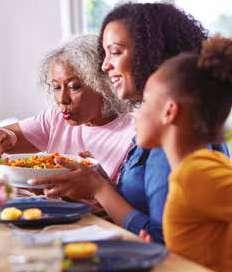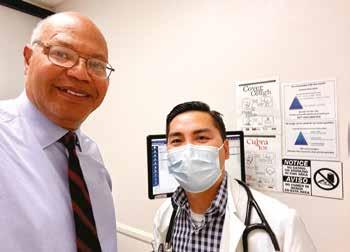
6 minute read
Study reveals that Blacks and Latinos at higher risk for type 2 diabetes

“We see a lot of Latino and Black people and sad to say, type 2 diabetes and its harmful effects are far too common with us,” said LaSalle Medical Associates CEO Dr. Albert Arteaga.”
Advertisement
THERE is an old saying that “You are what you eat.” And when it comes to what you eat and your chances of contracting type 2 diabetes, this is especially true.
According to the Food and Drug Administration, “You can inherit a predisposition for diabetes, a disease that disproportionately affects racial and ethnic minorities.” The FDA goes on to note that the death rate for Hispanics from diabetes is “50 percent higher than for non-Hispanic whites.”
The U.S. Department of
Health and Human Services Office of Minority Health research studies spanning the years 2018 and 2019 found that non-Hispanic Blacks were “twice as likely as non-Hispanic whites to die from diabetes” and “2.5 times more likely to be hospitalized with diabetes and associated long-term complications than non-Hispanic whites.”
San Bernardino County’s population is 55.8 percent Hispanic or Latino and 9.4 percent Black or African American, per the United States Census Bureau’s July 2022 estimates. In Riverside County, the percentages are 51.6 for Hispanics or Latinos and 7.5 for Blacks or African Americans.

“We see a lot of Latino and Black people,” said LaSalle Medical Associates CEO Dr. Albert Arteaga, “and sad to say, type 2 diabetes and its harmful effects are far too common with us.”
Type 2 diabetes is a major health concern for the Inland Empire and LaSalle Medical Associates works hard to address the problem.

Dr. Arteaga says, “Our physicians make it a point to discuss proper nutrition with patients they see who may be pre-diabetic or who have already been diagnosed with the disease.”
Several risk factors contribute to this problem and one of those is eating the wrong foods. Latino and African American diets often include fatty pork, foods fried or cooked with lard or unhealthy shortenings and oils, and starchy vegetables like beans, corn, potatoes, chickpeas, and parsnips, not to mention lots of sugary soft drinks and juices.
Some foods are loaded with refined sugars that few people think as high in sugar, including barbecue sauces, ketchup, baked beans, tomato soups and sauces, canned fruits and vegetables, salad dressings, and Asian-style sauces like Thai sweet chili and teriyaki. These, too, are often part of ethnic minority diets.

Now that the Covid pandemic has receded, LaSalle’s clinics are reaching out to encourage people to come in for preventive health screenings that include talking about diet and diabetes. “We see a lot of Latino and Black clients and we make sure that they get the facts about how important good nutrition is to their overall health and especially diabetes prevention and treatment,” said Dr. Arteaga.
“In addition to avoiding the bad foods, we recommend good ones: lean pork, chicken—especially with the skin off and roasted rather than fried, fish, and healthy veggies—spinach, kale, broccoli, beets, carrots, collard greens, cabbage, cucumbers, cauliflower, raw
By Marian Wright Edelman, Founder and President Emerita, Children’s Defense Fund
May 29 was Memorial Day in the United States, and the long weekend that is traditionally observed with shared American remembrance made headlines again for the shared all-American epidemic of gun violence.
The nonprofit Gun Violence Archive, which keeps track of American gun violence incidents, noted there were at least 175 people killed and another 496 injured during the Memorial Day weekend, and 20 mass shootings in which four or more people were injured or killed.
THIS included the mass shooting on a crowded beachside promenade in Hollywood, Florida that injured nine people, including four children, the youngest just one year old. Other shootings happened during neighborhood or community conflicts. Many happened at home, with a family member’s own gun.
College District
continued from page 4 motivational message drawing on his personal narrative. Rebecca Jauregui, who will be graduating from Los Angeles City College and recently had a two-week residency at the Los Angeles Theater Company, performed a traditional song and dance routine.
“I am thrilled to honor the tremendous accomplishments of our Latino students at LACCD’s second annual Mi Gente Graduation Celebration,” said Francisco C. Rodriguez, Ph.D., LACCD Chancellor. “As a first-generation English learner, the springboard of education changed the trajectory of my family and it can do so for our students and their families. I know firsthand
The Gun Violence Archive now calculates that more than 17,000 people have died so far this year in the U.S. from guns, including more than 100 children under age 12.
June is National Gun Violence Awareness Month, and June 2-4 is Wear Orange Weekend to join thousands of others across the country calling for an end to gun violence in all of its forms, including domestic violence, suicide, and city gun violence. The Wear Orange movement began in honor of Hadiya Pendleton, an honors student and drum majorette who was shot and killed on a Chicago playground in January 2013 just days after she had performed in President Obama’s second inaugural parade. As President Obama gave his State of the Union speech that year, he remembered Hadiya:
“She was 15 years old. She loved Fig Newtons and lip gloss . . . She was so good to her friends, they all thought they were her best friend. Just three weeks ago, she was here, in Washington, with her classmates, performing for her country at my inauguration. And a week later, she was shot and killed in a Chicago park after school, just a mile away from my house.”
As a sixth grader Hadiya had appeared in an anti-gang video to encourage other young people to avoid gang violence, saying, “It’s your job as students to say ‘no’ to gangs and ‘yes’ to a great future.” Hadiya could have meant a future like her own; the talented high school sophomore was excelling at her college preparatory school, doing everything right, with the world ahead of her. But all that changed because of a gun. Wear Orange began on June 2, 2015, the day that would have been Hadiya’s 18th birthday. It is now observed nationally every year on the first Friday in June and the weekend that follows. It was Hadiya’s friends who originally chose to remember her by wearing orange, the color hunters wear in the woods to protect themselves and others.
Hadiya Pendleton deserved to be protected. She, and the thousands of other children who have been killed by guns in our nation in the ten years since she died, deserved the freedom to grow up.
Last year, former First Lady Michelle Obama unveiled plans for the Hadiya Pendleton Winter Garden at the Obama Presidential Center in Chicago.
Mrs. Obama said, “I never had the chance to meet Hadiya while she was alive, but after she died, I was able to spend some time with her loved ones. I learned about how she was an honor student, how much she loved music, how she loved going out to get ice cream with her friends. And the more I heard, the more I understood the extraordinary potential inside her—a potential that was stolen by the epidemic of gun violence.”
She continued: “Like me, Hadiya was raised by parents who wanted to give her opportunities they never had. They signed her up for volleyball, cheerleading, and a dance ministry at church. They supported her education, and with their encouragement, she became a star student. From an early age, Hadiya’s parents made sacrifices to introduce her to opportunities throughout Chicago so that she could one day find her place in the world.” how empowering it is when students feel represented and supported. Today, we celebrate our graduates and their bright futures.”
Hadiya, who should be turning 26 right now, never got that chance. We must never tire of the really hard work demanded to transform the pervasive culture of violence and pervasive presence of guns in America. We must love our children more than the gun manufacturers and some NRA members love their guns. We must love our country enough to ensure the safety of our children and of all of us and demand the future free from gun violence that all of our children deserve.
District college presidents and graduates from all nine campuses delivered remarks and personal, inspirational testimony that was interspersed with performances from Ballet Folklorico de El Salvador and the GAHFU Traditional Garifuna Drumming Ensemble.
The honored student speakers were Miriam Vargas from West Los Angeles College, Kathy Carrillo from East Los Angeles College, Lindsey Lopez from Los Angeles Valley College, Karla Pulgarin from Los Angeles City College,
Jennifer Herrera from Los Angeles Southwest College, Airam Solorzano from Los Angeles Harbor College, Ubalda Jasso from Los Angeles Pierce College, Gabriela Penuelas Pettibone from Los Angeles Mission College and Angel Romero from Los Angeles Trade Technical College.
The event also included an outdoor stage with the Los Angeles City College Jazz Ensemble and food featuring cuisine from various Latin American countries. After the graduate speeches and performances, Jauregui returned to the stage for a closing song, “Que Bonito Amor,” that concluded the cultural celebration of student success.




